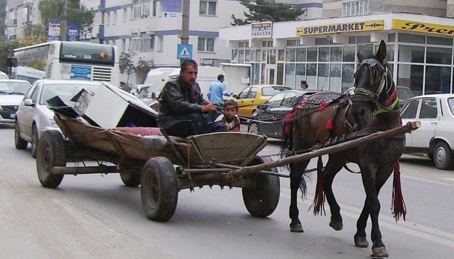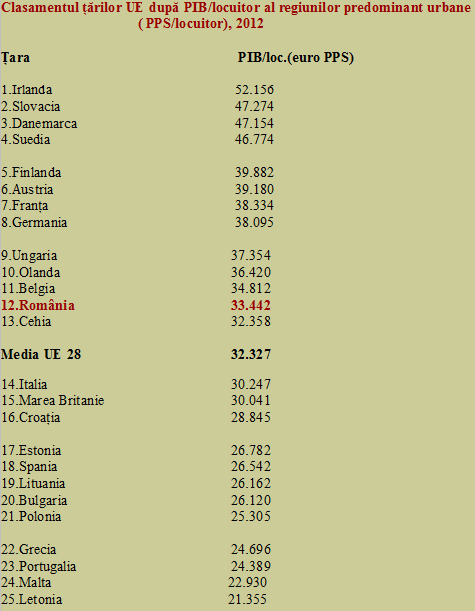
An analysis made by Eurostat based on the final GDP values for the recent years provides a big surprise for us.
Romania is ranked in the first half of the list containing 25 countries for which data were available about the living standards of residents in predominantly urban areas, calculated as GDP / capita adjusted for the price levels in the country as compared to the European average.
We note that this way of working with the parity of standard purchasing power (PPS) is currently used in statistics in order to ensure the comparability of data internationally.
According to the definition provided by Eurostat, predominantly urban regions are those regions of a country where the rural population represents less than 20% of the total population.
Ranking of EU countries by GDP / capita of predominantly urban regions

*
Tara = country
PIB/locuitor = GDP/ capita
Media UE 28 = EU 28 average
*
The three countries for which data have not been provided are Cyprus, Luxembourg and Slovenia.
Moreover, Romania is referred to as being ranked above the European average standards of living in the predominantly urban areas and the country exceeds powerful economies such as Italy or Britain.
Spain has been ranked six positions behind us with a GDP / capita of less than 20% and Poland only ranked in the last fifth, by almost 25% behind our country.
We are not though a singular case. Of the former Eastern bloc, Slovakia (2nd position after the champion of the predominantly urban regions, Ireland) and Hungary ranked far ahead of us.
Explanation: difference between urban and rural areas is of 34%, as compared to 5% in Germany. In the UK, rural inhabitants live better than those from the cities
The explanation for this paradox lies mainly not in the lower prices from some countries, but in the substantial differences existing at local level between urban and rural areas. Including those caused by the excessive concentration of development in certain areas (mainly the capital cities of somewhat less developed countries from the list).
Eurostat has considered to this end a welfare indicator as reference representing the proportion of people who reach or exceed 150% of the national average income per capita, based on three categories of urbanization (rural areas, cities and suburbs, large cities).
This is where we stand (unfortunately), ranking the first by the gap of these indicators between village and large cities, ahead of Bulgaria and with a higher degree of wealth concentration at the individual level in major cities than the Baltic countries.
Chart – Percentage of people having income greater or equal to 150% of the national average income by degree of urbanization (2014%)

If Romania has a difference of about 34% between major cities and rural areas (about 43% in the first and only 9% in the latter), countries like Austria or Germany falls within less than 5%.
Moreover, only in these countries the standard of living in the smaller cities, with their peripheries, and in larger cities is basically the same, which is a significant fact for the balanced development of a middle class.
The special situation of the United Kingdom in noteworthy, a country with a type of pronounced post-industrialization that caused an opposite context inconceivable for the Romanians. Proportion of those with higher incomes than the national average is higher in the rural areas, not in the cities.
Getting back to our situation, we are obviously in a special case.
The policies aimed at erasing the differences between urban and rural areas and between small towns and large cities in the recent years (or rather the lack of them) have brought us in this bizarre position, which explains why the perception we have when traveling abroad (usually in urban areas) or spending time in rural areas is significantly different from the general data.
Eurostat data represent a warning regarding the social cohesion and show us how far we are in terms of general practice. General practice not belonging to the old context of the socialist slogans but being in connection with objective necessities that are also valid for the development of European capitalism, as it proves to be.
If we still had chances, we should target the situation from the West.









